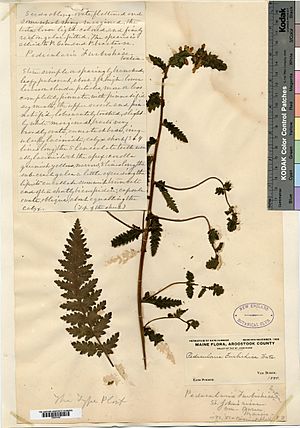Catherine Furbish facts for kids
Catherine 'Kate' Furbish (born May 19, 1834 – died December 6, 1931) was an American botanist. A botanist is a scientist who studies plants. Kate spent over 60 years exploring and drawing the native plants, also called flora, of Maine. She traveled thousands of miles across her home state. She made very detailed drawings and watercolor paintings of the plants she found.
Kate Furbish discovered two plants that were later named after her. These are Pedicularis furbishiae, known as Furbish lousewort, and Aster cordifolius L., var. furbishiae.
Contents
Kate Furbish's Early Life and Learning
Kate Furbish was born on May 19, 1834, in Exeter, New Hampshire. She was the oldest child and only daughter of Benjamin and Mary Lane Furbish. Soon after she was born, her family moved to Brunswick, Maine.
When Kate was a child, her father often took her and her five younger brothers for walks. They explored the woods near their home. Even at a young age, Kate was very good at identifying many of the local plants. This showed her early talent for botany.
Kate studied painting and French literature. She took drawing lessons in Portland and Boston. She even spent a year in Paris to improve her painting skills. In 1860, she attended botany lectures by George Lincoln Goodale in Boston. These lectures helped her learn more about plants, even though she did not go to college.
Kate's Personal Life and Independence
Kate Furbish was both an artist and a scientist. This was unusual for women in her time. She lived like a typical Victorian lady, dressing well and keeping her home neat. However, she was very independent and did not feel the need to marry. She often traveled alone.
In 1860, Kate became very sick after a trip. She spent the next 10 years getting her strength back. By 1870, she was well enough to start her walks in the Maine woods again. In 1873, her father passed away. He left her enough money to follow her passion for plants.
Local people often saw Kate on her walks. Some thought she was a bit strange because of her deep interest in plants and the outdoors. French Canadians in Maine called her "Posey Woman," which means "Flower Woman." Kate liked this nickname and felt it suited her. When asked why she cared so much about "weeds," she quoted Henry Wadsworth Longfellow. She said, "We feel the presence of God in Nature there, Nature grand and awful, and tread reverently where all is so hushed and oppressive in its silence."
Discoveries and Plant Studies


Between 1870 and 1908, Kate did most of her important work. She painted, collected, and classified Maine's plants. She traveled thousands of miles across the state. She used information from her lectures and a botany guide by Asa Gray to help her. Kate often explored wild, untouched areas. Her work resulted in over 4,000 sheets of dried plants and ferns. From 1897 to 1905, she also made famous drawings of Maine's 500 types of mushrooms.
In 1880, Kate was traveling in Aroostook County. She found a group of plants with dull yellow leaves. This plant was later named Pedicularis furbishiae, or Furbish's lousewort, by botanist Sereno Watson. This lousewort has only ever been found along a 130-mile stretch of the Saint John River. It is so rare that in 1976, a large dam project on the river was stopped to protect it. Another plant named after her is the Aster cordifolius L. var. furbishiae.
In 1894, Kate helped start the Josselyn Botanical Society of Maine. She served as its president from 1911 to 1912. Kate collected over 1,300 watercolors and pressed plant samples. She put them into fourteen books, which she called "Flora of Maine."
Kate Furbish's Legacy and Impact
In 1908, Kate decided to share her life's work. Her "Flora of Maine" books were given to Bowdoin College. Her 182 sheets of pressed ferns went to the Portland Society of Natural History. Her 4,000 sheets of dried plants were donated to the New England Botanical Club. These are now kept at Harvard University's Gray Herbarium. Her work covered plants from over 200 towns in Maine.
Kate Furbish passed away on December 6, 1931, at the age of 97. She was well-known among plant scientists and nature lovers. Her watercolors and drawings are still highly valued today. Kate's renewed popularity helped show the importance of amateur, or non-professional, scientists in plant studies.
In June 2018, the town of Brunswick, Maine, announced that a new elementary school would be named in her honor. The Kate Furbish Elementary School opened in the fall of 2020. It serves students from pre-kindergarten through second grade.
See also
In Spanish: Catherine Furbish para niños


